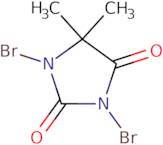
1,3-Dibromo-5,5-dimethylhydantoin
CAS: 77-48-5
Ref. 3D-FD05957
| 25g | To inquire | ||
| 50g | To inquire | ||
| 100g | To inquire | ||
| 250g | To inquire | ||
| 500g | To inquire |
Product Information
- 1,3-Dibromo-5,5-Dimethylimidazolidine-2,4-Dione
- 1,3-Dibromo-5,5-dimethyl-2,4-imidazolidinedione
- 1,3-Dibromo-5,5-dimethyldantoin
- 1,3-Dibromo-5,5-dimethylimidazolidin-2,4-dione
- 2,4-Imidazolidinedione, 1,3-dibromo-5,5-dimethyl-
- 5,5-Dimethyl-1,3-dibromohydantoin
- 5-Dimethylhydantoin
- Bromodan
- DDH
- Dbdmh
- See more synonyms
- Dibromantin
- Dibromantine
- Dibromo-5,5-dimethyl hydantoin
- Dibromohydantoin
- Hydantoin, 1,3-dibromo-5,5-dimethyl-
- N,N′-Dibromo-5,5-dimethylhydantoin
- N,N′-Dibromodimethylhydantoin
- NSC 33305
1,3-Dibromo-5,5-dimethylhydantoin (DBDMH) is a disinfectant that is used in the treatment of wastewater. It is an organic solution with a high water solubility and low toxicity. DBDMH has fluorescence properties and can be detected using analytical chemistry techniques. The most common use of DBDMH is as a nutrient solution for plants. It can also be used as a disinfectant in flow systems and as a sodium carbonate substitute. In addition to its use as an analytical reagent, it has been shown to have anti-microbial activity against bacteria such as Escherichia coli and Staphylococcus aureus at concentrations of 40 ppm or less, with no adverse effects on plant growth when used at higher concentrations. DBDMHI is not very soluble in water but can be dissolved by adding sodium carbonate or hydrochloric acid to produce an alkaline solution.
Chemical properties
Technical inquiry about: 3D-FD05957 1,3-Dibromo-5,5-dimethylhydantoin
If you want to request a quotation or place an order, please instead add the desired products to your cart and then request a quotation or order from the cart. It is faster, cheaper, and you will be able to benefit from the available discounts and other advantages.





